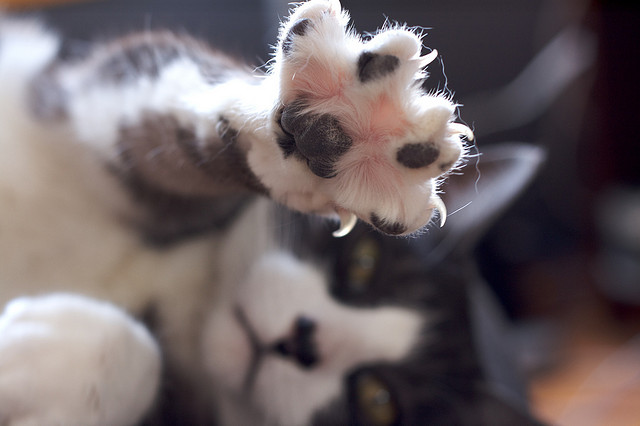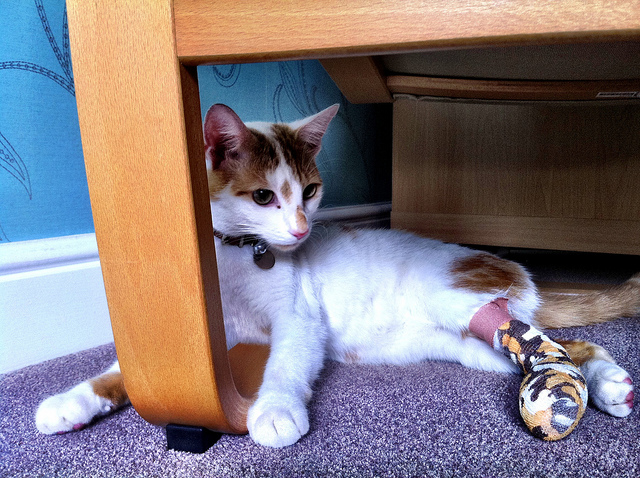
Dog nails grow continually, like a human’s nails. But cat nails grow in layers — like an onion.
Ripped cat nails are pretty rare. That’s because if the nail gets caught in something (like carpeting, curtains or furniture), the outer nail simply peels away, exposing a healthy nail underneath.
If you notice that your cat favors a paw while walking, it could indicate a torn nail. Again, it’s unlikely, but it could happen.
First, take a good look at the nail. If it looks infected, take your cat to the veterinarian. In fact, if you have any doubt, give your vet a call.
Treating a Torn Cat Nail
- Stop the toe from bleeding.
- Remove the partially detached nail from the toe using clippers.
- Clean the toe daily.
- Bandage the paw to prevent injury and infection.
- Change the bandage and bathe the wound daily.
- Monitor the toe for signs of infection.
Stop the Bleeding
There are several steps involved in treating a torn cat nail — and they vary slightly depending on whether or not the nail is still attached to the toe.
If the nail was freshly ripped and is still bleeding, stop the bleeding using the following tips:
- Snip away any part of the nail hanging from the tear. Keep in mind that the toe is sore and your cat may be sensitive. Have someone help you hold the cat to avoid potential bites.
- Use a styptic pencil or pad to stop the bleeding. These contain a compound of alum or silver nitrate that, when placed on a cut or wound, cause a reaction between the compound and the capillaries in the skin, thereby sealing the wound. This is a quick and painless way to stop the bleeding from the toe.
If you don’t have a styptic pencil or pad, sprinkle a little flour or cornstarch on the toe to stop the bleeding.
Some nail tears can be prevented by regularly clipping your cat’s claws.
Watch how this vet effectively clips a cat’s nails:

Remove the Nail
If the broken nail is dangling from your cat’s toe, remove it before treating the wound. If you don’t, it may get painfully pulled off as the cat walks or plays, so it’s best to remove it quickly.
Assess how much skin is attached to the nail. If it is barely hanging on, give it a quick snip. Use a pair of pet nail clippers to cut the nail off where it is broken.
But if the nail is broken at the base, forget about using the clippers for now, so you avoid damaging the bone of the toe. Wait for the nail to grow a bit or take your cat to the vet for further treatment.
Clean the Wound
Once the nail is removed, you need to clean the wound to help prevent infection.
Rinse your cat’s paw gently using warm water — this removes dirt and loose debris from the paw that could cause infection in the toe. Apply pet antiseptic spray to the wound to kill germs, help prevent infection and reduce discomfort.
Bathe the paw twice a day, and follow up with the antiseptic spray. Watch for swelling or pus each time you bathe the paw, as this indicates that the toe has become infected and will require a vet’s treatment.

Bandage the Wound
When animals have an injury, they tend to lick the sore area repeatedly. This can slow down the healing process and cause further damage or infection.
If your cat allows you to do so, bandage the wound lightly. Use a regular first aid bandage, or a less traditional method of bandaging the wound. Slipping a clean sock over the paw and then applying first aid tape to hold it in place makes an effective bandage for a sore toe.
Was YOUR Pet Food Recalled?
Check Now: Blue Buffalo • Science Diet • Purina • Wellness • 4health • Canine Carry Outs • Friskies • Taste of the Wild • See 200+ more brands…

If your cat constantly tries to remove the bandage, buy a plastic cone collar to their reduce access to the wound while it heals.
You have to change the bandage or sock every day. Bathe the paw after removing the bandage and then apply a fresh bandage after bathing. Your cat will leave the toe alone when it is no longer uncomfortable, so you can remove the cone after a couple of days.
A torn claw, when growing back, can sometimes become crooked or ingrown. Both of these conditions cause discomfort for your cat, and an ingrown nail can easily become infected.
If either of these conditions occurs, take your cat to the vet for treatment. Monitor the toe for the following signs of infection:
- Redness and swelling
- Pus discharged from the wound
- Blood, possibly mixed with pus, discharged from the wound after healing has begun
To help prevent your cat from suffering a torn nail in the future, trim all of their nails once a month, and make sure your cat has a good scratching post made from a tightly woven fabric on which to scratch and play.
 This pet health content was reviewed for accuracy by a veterinarian, Dr. Pippa Elliott, BVMS, MRCVS. This article was originally published in 2013 and was last reviewed and updated May 1, 2019.
This pet health content was reviewed for accuracy by a veterinarian, Dr. Pippa Elliott, BVMS, MRCVS. This article was originally published in 2013 and was last reviewed and updated May 1, 2019. 

